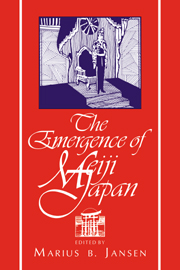2 - Late Tokugawa culture and thought
Published online by Cambridge University Press: 05 June 2012
Summary
The Culture of Play
Japanese historiography has conventionally located the beginning of the end of the Tokugawa (bakumatsu) in the decade of the 1830s, when the regime and the several domains embarked on a series of reforms aimed at arresting economic failure and restoring public confidence. Historians who have concentrated on making sense of the signs of financial failure point to the implementation of the Tempō reforms as recognition of a gathering crisis. Some have established the revolt of Ōshio Heihachirō in Osaka in 1837 as the turning point in Tokugawa history. But regardless of the many opinions concerning the beginning of the end, most discussions of the end of the shogunate have used economic signs, political events, or a combination of both as criteria for periodization. Yet to establish the beginning of the end in the 1830s obliges us to accept a concomitant assumption that cultural events constitute a second order of activity; one that avoids organizing the world in terms of a base–superstructure dyad but still sees culture and ideas as determined by material forces. Culture is then made to appear as a dependent variable of economic and political processes, and the observer is diverted from recognizing that the production of culture may in fact possess a logic of its own, one that seeks to resolve problems belonging to an entirely different class of events and facts.
- Type
- Chapter
- Information
- The Emergence of Meiji Japan , pp. 53 - 143Publisher: Cambridge University PressPrint publication year: 1995
- 1
- Cited by



